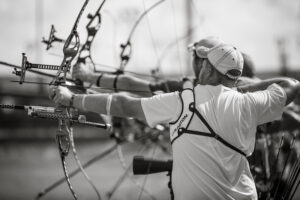Professional archers make the sport look deceptively easy. On the contrary, if you’re not executing your shot routine with the required strength, flexibility and alignment, it’s very likely that you will injure yourself, primarily your rotator cuff or shoulder. Elbow injuries are also common, but these are usually caused by the repetitive motion of shooting and/or a bow that has too much high-frequency vibration.
A rotator cuff injury can be severe enough to end an archer’s career. It occurs when an archer draws back the bowstring in a strained, inefficient way or when they shoot with poundage that is too heavy for them. To prevent this type of injury, your best bet is to seek the advice of an experienced coach who can instruct you on how to properly draw back a bow string. Keep in mind that there isn’t only one way to pull the string back. You’ll have to make accommodations for your body type and shooting style in order to do this without causing any problems.
Some recurve archers develop bicipital tendonitis – a strain of the lateral deltoid – on the string arm. This happens when the archer uses primarily their biceps and shoulders instead of their back muscles to execute their shot. As with most cases of tendinitis, you should rest (stop shooting), apply ice and take an over-the-counter pain reliever such as ibuprofen. In addition, seeking the help of a medical professional could help speed up recovery time, as they can give you rehab exercises that will also help prevent further injury.
Besides the shoulders, elbows are prone to injury as well. Tendonitis and tennis elbow are the common diagnoses here. The repetitive motion of archery can lead to tendonitis in either or both elbows, and the physical weight of the bow in combination with its repeated high-frequency vibration causes tennis elbow. Unfortunately, the repetitive nature of archery cannot be changed, so reducing elbow tendonitis can be difficult. Sometimes lowering draw weight helps, but doing ongoing rehab is probably the best option. In order to reduce tennis elbow, try lowering the mass weight of your bow and stabilizer weights, as well as making sure that proper vibration damping is installed on the stabilizers to reduce hand shock.
Injuries in archery are sometimes minor, but they can lead to more serious problems if they aren’t addressed. If you suspect that you might have an injury in your shoulders or elbows, seek the help of an experienced coach and possibly a physiotherapist too. In this case, it’s definitely better to be safe than sorry.



